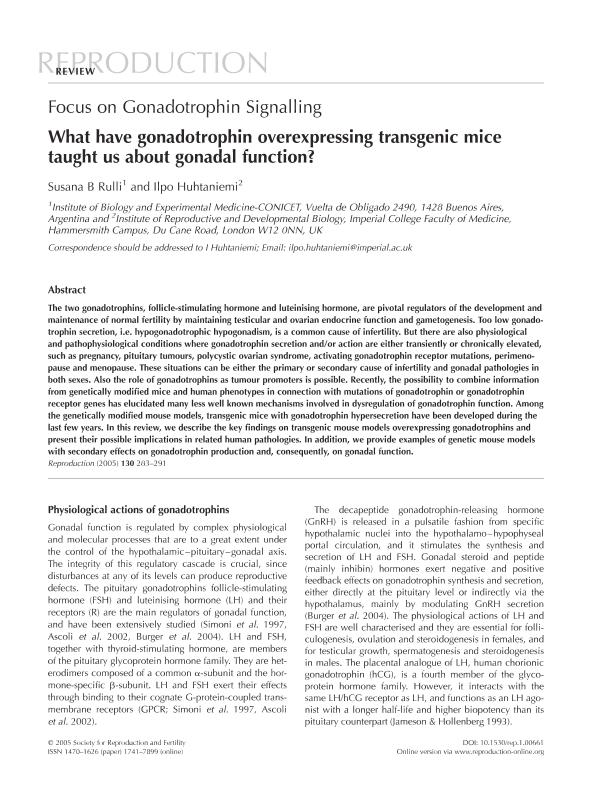Mostrar el registro sencillo del ítem
dc.contributor.author
Rulli, Susana Beatriz

dc.contributor.author
Huhtaniemi, Ilpo
dc.date.available
2018-02-08T13:35:45Z
dc.date.issued
2005-09
dc.identifier.citation
Rulli, Susana Beatriz; Huhtaniemi, Ilpo; What have gonadotrophin overexpressing transgenic mice taught us about gonadal function?; Society for Reproduction and Fertility; Reproduction; 130; 3; 9-2005; 283-291
dc.identifier.issn
1470-1626
dc.identifier.uri
http://hdl.handle.net/11336/36090
dc.description.abstract
The two gonadotrophins, follicle-stimulating hormone and luteinising hormone, are pivotal regulators of the development and maintenance of normal fertility by maintaining testicular and ovarian endocrine function and gametogenesis. Too low gonadotrophin secretion, i.e. hypogonadotrophic hypogonadism, is a common cause of infertility. But there are also physiological and pathophysiological conditions where gonadotrophin secretion and/or action are either transiently or chronically elevated, such as pregnancy, pituitary tumours, polycystic ovarian syndrome, activating gonadotrophin receptor mutations, perimenopause and menopause. These situations can be either the primary or secondary cause of infertility and gonadal pathologies in both sexes. Also the role of gonadotrophins as tumour promoters is possible. Recently, the possibility to combine information from genetically modified mice and human phenotypes in connection with mutations of gonadotrophin or gonadotrophin receptor genes has elucidated many less well known mechanisms involved in dysregulation of gonadotrophin function. Among the genetically modified mouse models, transgenic mice with gonadotrophin hypersecretion have been developed during the last few years. In this review, we describe the key findings on transgenic mouse models overexpressing gonadotrophins and present their possible implications in related human pathologies. In addition, we provide examples of genetic mouse models with secondary effects on gonadotrophin production and, consequently, on gonadal function.
dc.format
application/pdf
dc.language.iso
eng
dc.publisher
Society for Reproduction and Fertility
dc.rights
info:eu-repo/semantics/openAccess
dc.rights.uri
https://creativecommons.org/licenses/by-nc-sa/2.5/ar/
dc.subject
Gonadotrophin
dc.subject
Transgenic Mice
dc.subject
Reproduction
dc.subject
Tumors
dc.subject.classification
Inmunología

dc.subject.classification
Medicina Básica

dc.subject.classification
CIENCIAS MÉDICAS Y DE LA SALUD

dc.subject.classification
Biología Reproductiva

dc.subject.classification
Ciencias Biológicas

dc.subject.classification
CIENCIAS NATURALES Y EXACTAS

dc.title
What have gonadotrophin overexpressing transgenic mice taught us about gonadal function?
dc.type
info:eu-repo/semantics/article
dc.type
info:ar-repo/semantics/artículo
dc.type
info:eu-repo/semantics/publishedVersion
dc.date.updated
2017-12-28T13:40:23Z
dc.identifier.eissn
1741-7899
dc.journal.volume
130
dc.journal.number
3
dc.journal.pagination
283-291
dc.journal.pais
Reino Unido

dc.journal.ciudad
Teddington
dc.description.fil
Fil: Rulli, Susana Beatriz. Consejo Nacional de Investigaciones Científicas y Técnicas. Instituto de Biología y Medicina Experimental. Fundación de Instituto de Biología y Medicina Experimental. Instituto de Biología y Medicina Experimental; Argentina
dc.description.fil
Fil: Huhtaniemi, Ilpo. Imperial College London; Reino Unido
dc.journal.title
Reproduction

dc.relation.alternativeid
info:eu-repo/semantics/altIdentifier/url/http://www.reproduction-online.org/content/130/3/283.long
dc.relation.alternativeid
info:eu-repo/semantics/altIdentifier/doi/http://dx.doi.org/ 10.1530/rep.1.00661
Archivos asociados
